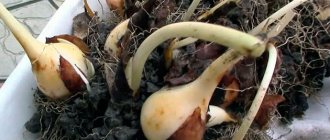The lilies have bloomed, what next: briefly about lilies
The lilies have faded, what to do next?
All summer residents adore lilies for their beauty and unpretentiousness. Caring for them is not difficult, and their appearance will delight all gardeners who decide to plant this flower. In order for the lily to please you for more than one season, and to bloom, in principle, without diseases, you need to adhere to a couple of rules for care. You especially need to pay attention to caring for lilies that have already bloomed. It is sufficient to explain this by the fact that the future of the lily depends on the bulb. If the bulb grows and develops under normal conditions, then the flower will continue to grow well and delight your eye for a long time. Since the bulb is formed after the lily fades, this moment cannot be missed. After the lily fades, you need to immediately begin caring for the bulbs.
Trimming
Proper pruning of lilies after flowering will create favorable conditions for the full growth and development of the bulb in the ground. Often, novice gardeners make a serious mistake by immediately cutting off lilies as soon as their buds begin to fade. Carrying out the procedure so early is strictly prohibited: the fact is that the above-ground green part provides important photosynthesis processes, without which the normal development of the bulb cannot be seen.
The bulb cannot obtain useful substances on its own, and pruning deprives it of the opportunity to strengthen itself due to the oxidative processes occurring in the foliage and stems. Thus, the development of the bulb stops, and it may not even survive the winter. And even if it does, the lily will hardly be able to bloom next year.
To avoid this problem, you need to prune only after the leaves fall off on their own. After flowering and petals fall, remove only the seed capsule and leave the foliage intact. If you are concerned about the unsightly appearance of your flower bed, plant later-blooming plants in the foreground in advance.
The lilies have bloomed, what next? Errors in care
Gardeners often make the mistake of believing that a lily does not require any care at all. They just water it and pull out the weeds. It is believed that the lily does not need to be covered for the winter and transplanted to a new place every year. However, this is not entirely true and the lily needs care, albeit not a lot. After all, at first you can really think that the lily does not require care, because in appearance it does not give signs that it needs care. But after a while it will be clear that lilies are not doing so well without care. The flowers will be smaller and their number will also decrease. To avoid this, you need to take at least a little care of the lily. When cared for, the lily will produce large flowers and delight your eye for a long time. In addition, the lily must be replanted, since without this it will grow and interfere with other lilies.
That is why now we will analyze the care of lilies that have already bloomed. Because, as practice shows, summer residents do not know how to care for the bulbs.
Bulb Digging Procedure
Lilies do not require annual replanting; they grow quietly in one place for 5 years. However, there are several reasons when flowers still need to be planted:
- reproduction or change of site;
- characteristics of a particular variety;
- poor frost resistance of some varieties;
- reduction in flowering quality;
- blackening, rotting and wilting of shoots;
- depressed appearance of flowers.
Dig out the bulbs 4-6 weeks after the lily has flowered. The digging procedure is carried out as follows:
- Dried flower stalks are cut off, the bulb is carefully removed from the soil and cleaned of adhering soil.
- The peeled bulbs are sorted out, the diseased, dried and rotten ones are destroyed.
- The babies are separated from the mother onion, for disinfection they are soaked in a dark pink solution of potassium permanganate for 1 hour and dried in a semi-dark, well-ventilated place.
The dried planting material is placed in a cool room for further storage.
The timing of digging depends on the plans of the grower: if planting lilies is planned in the fall, then the bulbs are dug up in August. And those intended for spring planting - in early October.
Do I need to cut the stems of lilies after flowering?
And the first thing you should pay attention to is that the lily cannot be touched. If the time approaches autumn and the moment when the flower fades, then it must do it itself. It cannot be pulled out, cut off or torn off. You may think that by doing this you are helping, but no, you are only making things worse. Even if you cut lilies for bouquets, this has a bad effect on their future flowering. After all, by interfering with this process, you shorten the life of new lily flowers. Therefore, if you decide to breed a lily yourself, then under no circumstances should you pick its flowers. The flowers themselves should fade and then future flowers from their bulbs will be just as large and bloom for just as long and delight you. There is also a mistake that all gardeners make. After our plant fades and the flower falls, a stem remains in its place, which under no circumstances should be cut off, even though it does not look beautiful. For example, other plants, such as tulips, can be trimmed with this thing and nothing will happen. It is worth understanding this system, why this stem should not be trimmed and how it affects the bulb. The fact is that after the lily fades, all the emphasis in the plant goes to the bulb. It turns out that by cutting this stem you deprive the bulb of nutrients. When the bulb does not receive the required amount of substances, it has a bad effect on the future of the lily. The flowers will be small and will not grow for long; they will not be so lush and bright. Of course, lilies that have just bloomed do not look very pretty. However, this problem can be solved very simply. You just need to plant beautiful other plants next to the lilies, which will cover the unattractive stems and bulbs after the lilies have bloomed. You can also plant tall grass, the main thing is to divert attention from the lily to another plant. As an option, plant lilies next to conifers. This is an excellent solution to our problem, since the needles retain their bright green color all year round, which suits our case. When the lily fades, the needles perfectly camouflage our bare stems. And during beautiful flowers, plain needles will only emphasize the brightness of the lily flowers. In general, it is worth choosing a plant that is monochromatic, preferably larger than a lily in size and spreading. Such plants can only highlight our lily, and not block it, making it completely unnoticeable.
How is the bulb formed?
A lily bulb is a modified shoot located underground. It has a thickened short flat stem, called the bottom, and overgrown fleshy leaf bases, which are called scales. In lilies they are white because they lack chlorophyll. The scale-like leaves sit loosely on the bottom and are easily separated. The closer to the middle, the larger they are. Along the edges there are outer scales, which are much smaller than the inner modified leaves. In their axils there are buds, from which, every year, under favorable conditions, above-ground shoots and daughter bulbs called children develop.
Because of these developmental features of lilies, cutting leaves on them is prohibited. Experienced gardeners leave them until spring, and during this time they have time to completely decay and turn into natural food for the bulb. If the owner of a flower garden wants to admire his flowerbed next year, he must treat all parts of this flower with care.
Bulbs in any plant are a perennial form of existence of the species. It increases in size and is capable of division. The flowering shoot of a lily develops from the apical bud, and in large specimens several apical buds may form, which leads to the formation of additional bulbs the following year, which will need to be planted in the fall. If there are such specimens with several peduncles in the flower garden, then one of the flowering stems can be cut off, but the others should be left for the full development of the bulbs so that the plant can bloom the next year.
The root tuber of a lily allows the plant to begin vegetative regeneration. In the spring, at favorable temperatures, the bulb begins to expel a flower bud, and the leaf embryos begin to develop, using the supply of water and nutrients accumulated in the past season. When the flower finishes flowering, it forms seed pods. To prevent this from happening, flower growers remove bright stamens that have not yet had time to be covered with pollen and fall on the pistil. If left, the bulb will work to produce seeds. As a result, the mother plant will die in winter, but the species will survive, continuing its life from the seed. This is how nature updates the genetic codes, and viral and bacterial diseases of the underground part of the plant cannot destroy the plant species.
If a flower dries up without being fertilized, its leaves continue to live. Those who doubt whether they need to prune lilies after flowering should remember the peculiarities of the formation of the bulb of this flower. Leaves accumulate nutrients that are collected at their base. This causes them to swell and form into new bulbs. The axillary buds remaining on the bottom develop into daughter bulbs. They separate and give rise to new plants.
Untimely digging of a lily leads to the death of the flower. The not yet formed bulb may then dry out during storage or become a breeding ground for viruses and bacteria, which will eventually destroy the entire plant.
How to feed lilies after flowering
As with any plant care, lilies require fertilizer. Our flower needs them during flowering and especially after the lily has faded. Since the bulbs need nutrients, the plant itself may not be enough. In this case, it is better to play it safe. Lilies especially love phosphorus fertilizers. In any case, you need to take care of fertilizer if you want to admire the same beautiful, bright and lush flowers next year. We need to pay attention to the fact that mineral fertilizers are not suitable for our lily. This happens because they give a short-term effect and then all gardeners notice that their lilies grow sluggish and sick. This can be explained by the fact that mineral fertilizers are not enough for a long time and the lily was not saturated with the required amount of nutrients. And the bulbs really need them, since in the fall they must absorb as many nutrients as will last until spring. It is phosphorus fertilizers that will help solve this issue. Lilies also love humus, but it is not recommended to use fresh humus, as it may burn the stems and bulbs. This will not lead to anything good and the lily will be sick in the future. But second-year humus is perfect for fertilizer. Since the molecules that can corrode the lily bulbs are already softened and do not harm the bulbs and only have a positive effect on the lily. Last year's manure has an excellent effect on the growth and further development of the lily. You can also use special fertilizer solutions that can be purchased at gardening stores. They are made specifically for lilies and are not suitable for other plants.
How often should lilies be replanted?
A lily can grow quietly in one place for 4-5 years. But during this time, the bush becomes overgrown with children and becomes dense, as a result of which, although it looks beautiful and lush, the flowers themselves become noticeably smaller. To restore large caps of inflorescences, lilies need to be planted in the 5-6th year of life, and at the same time propagating them.
This is best done in the fall, a couple of weeks after flowering ends, but not before the peduncle (stem) dies.
In addition, some varieties of lilies cannot overwinter in open ground (for example, trumpet lilies), and in the fall they must be dug up and stored until spring.
When to dig up lilies
This is a very controversial issue that depends on many factors. If your lily has never been transplanted and you notice that it has grown very large, then you should think about replanting. When the stem has completely faded, the bulb should be dug up and planted in a new place. With this you give new life to your lily. Digging should occur a month after the flowers have faded. It also depends on the type of lily, because some varieties do not need replanting and without it they bloom for a long time and without disease. Other varieties, on the contrary, require frequent replanting, since their new bulbs do not give their mother a chance for further flowering.
Varieties of lilies: which ones to plant
I planted lily bulbs. In the first year they bloomed well, in the second year they bloomed much worse, and in the third they disappeared completely. I dug up the soil and found only small bulbs. Where did the bulbs I planted go?
Most likely, you planted oriental or American hybrids, which in our country practically do not have time to restore the bulb after flowering, and it gradually weakens and even dies completely. These types of lilies bloom late, and rainy, cold weather begins to destroy the leaves. Without them, the bulb cannot recover after flowering, during which the entire supply of nutrients accumulated in it is consumed, and there is not enough heat. Thus, before winter the bulb leaves weakened. Gradually she weakens so much that she dies completely.
Another possible reason is the bulbs getting wet if the area where they are planted is flooded with meltwater in the spring and rain in the summer. In addition, the bottoms of the bulbs could rot. This often occurs in acidic soils with excess soil moisture or when the bottom of the bulbs is damaged by wireworms.
Sometimes the bulb rots due to poor-quality planting material or due to damage by snails and other soil pests. Before planting any bulbous crops, it is recommended to treat the planting material against rot in the preparation “Maxim”.
What varieties of lilies can be planted in the North-West?
In the North-West, Oriental, American, and Japanese hybrids do not work well. Only Asian and LA hybrids, obtained by crossing Asiatic and trumpet lilies, bloom well and overwinter without shelter. Tubular lilies overwinter only under the cover of spruce branches.
To successfully overwinter oriental hybrids, they should be covered with a layer of dry foliage of at least 20 cm and the plantings should be covered with film on top to prevent moisture from penetrating under the cover. You can use high-moor peat as a cover, also in a 20 cm layer, but without a film on top of the peat. You can cover the plants with soil and cover them with spruce branches. In early spring, all this must be removed, otherwise the lilies will begin to grow too early and be subject to spring frosts.
Oriental hybrids and other species crossed with them are usually transplanted into a glass greenhouse in late summer.
Martagon grows and blooms in the North-West. Everywhere, Daurian lilies grow beautifully, bloom and winter without shelter. In warmer climates, especially those with long, warm and dry autumns, both trumpet and white royal lilies, oriental hybrids and other types of lilies grow well.
American and Japanese hybrids can only be grown in a subtropical or similar climate zone.
How to properly cut and preserve lilies?
Generally speaking, lilies are cut flowers. But you can cut only those plants that have 5–7 buds (they have a large bulb). Lilies are cut when the first bud has just begun to open.
If the lily has only 1-2 buds, you cannot cut it yet, since its bulb is too small. When cutting, you deprive the plant of the leaves necessary to restore and grow a large bulb.
Never cut off the entire stem. Leave at least a quarter of the stem with leaves to restore the bulb.
If transportation is to be done, it is better to do the cutting early in the morning. Burn the ends of the stems in a candle flame or dip them in melted paraffin. Then wrap the lilies in paper and pack them in a plastic bag (tying it) or in a cardboard box (sealing it with tape). The flowers will endure quite a long journey just fine.
Before putting them in water, the ends of the stems need to be trimmed. To give nutrition to cut plants, you can add 1 teaspoon of granulated sugar to 1 liter of water. And to protect them from putrefactive bacteria, add a grain of citric acid or manganese.
Digging algorithm
However, digging up lilies also has its own characteristics. Now an algorithm for digging will be provided.
1. First you need to dig up the bulb along with the stem, which needs to be trimmed in advance. At this stage you should be very careful and be gentle with the bulb.
2. Also carefully remove the remaining soil from the bulb.
3. Next, a careful inspection of each bulb is carried out. If you find any rot or something suspicious, you need to cut it off and clean the onion from foreign bodies.
4. After all this, the bulbs need to be washed.
5. Next, the bulbs should be placed in a disinfection solution for an hour. This represents protection against disease and ensures the future lily a long life.
6. After such disinfection, the bulbs must be dried in the shade without exposure to the sun.
7. The final step is to store the bulbs in a cool place.
Bulb storage
Depending on what types and varieties of lilies are grown on the site, an action plan is outlined in relation to their bulbs.
Some types of these flowers are distinguished by good frost resistance and can winter in the ground even in Siberian conditions.
Asian hybrids are able to perfectly tolerate negative temperatures, but for trumpet lilies, for example, such weather conditions are undesirable - they may die.
Therefore, before choosing a method of preparing for winter, you need to study the characteristics of the variety.
If the lilies grown on the site belong to non-frost-resistant varieties, then their bulbs will have to be dug up in mid-autumn and sent for storage in the basement or cellar, where the temperature will not drop below 2 - 3 ° C.
Each variety has its own storage temperature that must be adhered to.
Some varieties of lilies can be simply left in the refrigerator.
To store lily bulbs, sprinkle them with sand, sawdust or earth. If you plan to force lilies in winter, then plant the bulbs directly in a pot with a substrate prepared for this purpose.
You can leave the bulbs in the ground, then you need to create a shelter for them - mulch. For this, leaves, peat, sawdust, bark or other plant debris are used; it is advisable to cover the top with agrotextiles or film.
After the onset of favorable spring temperatures for the plant, the shelter must be removed.
Lilies have bloomed: how to cover lilies for the winter
As practice shows, lilies cope well without shelter for the winter, but this also depends on the variety. In principle, you can read what your particular variety needs on the packaging or find detailed information in another article. In most cases, snow is enough. But it is advisable not to experiment and cover the ground with autumn leaves or pine needles, so that the roots of the lily do not freeze and dry out from frost. Needles are best suited because parasites do not form under the needles, which can also devour the roots.
Pruning faded lilies
Do not prune immediately after flowering, because the plants need to gain strength to survive the winter safely. During budding and at the end of summer, photosynthesis occurs - a process carried out by all green crops, saturating the roots and bulbs with oxygen. With early low pruning, sap stops flowing to the root system, which creates a risk of freezing. Here's how to care for flowers at the end of summer:
- Immediately after flowering, cut off the seed capsule.
- When the leaves turn yellow and the protruding stems begin to dry out, prune them: remove the above-ground part of the plants, their length should be 10-15 cm. The time for such pruning depends on the climatic characteristics of the area. As a rule, work occurs in early to mid-September.
- Collect and burn the cut off ground parts of the flowers.
If you are embarrassed by faded plants, then plant roses, tulips, peonies, juniper, Turkish carnation, and hosta around them. The flowering periods of these crops are different (beginning, middle, end of summer), so the flowerbed will delight you with its splendor at any time. It is not recommended to leave withered stems of lilies until spring, because pests and parasites can hide in them, which, with the onset of warm weather, will begin to actively multiply and harm garden crops.
Lilies after pruning before digging
In the spring
In spring, you need to remove the frost protection immediately after the thaw. Since the lily should grow in the light, however, after winter it is quite weak and may finally weaken due to still cold nights. This will have a bad effect on the further development of the lily. It is worth understanding that how your lily overwinters determines its future flowering, life expectancy, flower size, color brightness and much more. You also need to take transplantation seriously and understand that with any bad effect on the bulb, the consequences will not be so good.
Wintering in the ground
Many gardeners leave even the most delicate varieties of lilies in the ground for the winter. All that is needed is to insulate them efficiently. To do this, fill the bed with peat before frost sets in. When the soil freezes a little, create a thick layer of dry leaves, pine branches, straw or sawdust, cover it with a film on top, which will serve as reliable protection from melt water in the spring. As the weather warms up, remove polyethylene and dry leaves, sawdust or pine branches. Leave the peat, it will serve as an organic fertilizer.
Remember that it is recommended to open plants in the spring after the snow has melted. There is no need to specially dig up lilies, because the bright spring sun will provoke the development of sprouts that will be damaged by frost. Do not be late in removing the mulch at the end of summer, otherwise the above-ground part of the lilies will not grow well due to lack of light.
Lily diseases
Lily is a fairly unpretentious plant, but insects and improper care can have a detrimental effect on the health of the flower. Below are common diseases and parasites, as well as ways to combat them:
- lily flies. They lay eggs in unopened buds. When the larvae emerge, they feed on the stamens and petals. This is why lilies' buds fall off without blooming. To avoid damage to the plant, it is necessary to treat the buds against pests immediately after ripening. Treatment includes several measures at once - spraying, processing equipment and removing damaged parts of the plant;
- gray rot. Sometimes brown or red spots appear on the leaves, this disease is called botrytis. The fungus penetrates the plant and multiplies well in damp weather. To avoid disease, you need to spray the plant with zircon and often loosen the soil. If it is acidic, then treat with a solution of potassium permanganate;
- excess moisture, nitrogen deficiency is the answer to the question why lily leaves turn yellow or begin to fall off. To avoid the death of the plant, it is better to apply fertilizer when the plant is planted. It is also important to maintain moderate watering, then the lily will not shed its leaves.
A plant infected with gray rot
Note! The best ways to combat diseases are prevention and timely assistance. When seedlings appear in the spring, they need to be treated with a solution of soda, ammonia, and copper sulfate.
Caring for lilies in the garden
The lily requires special care; you need to feed the plant and water it properly.
If the flower is young, then the first fertilizing should be done after flowering with potassium-phosphorus fertilizer. The plant, which is about 2-3 years old, needs to be fed after the snow melts with nitrogen fertilizers, for example, nitrate. The second feeding is carried out during the formation of buds, and the third immediately after flowering.
Lilies need moderate watering to avoid stagnation of water, as this can lead to rotting of the bulbs. Abundant watering is needed in April-May, when the plant is just gaining strength, and after flowering, in order to accumulate nutrients and gain strength for wintering.
Important! After flowering, it is necessary to prune the plant, you need to cut off the faded buds. The stems with leaves should be left, as the process of photosynthesis continues, the plant gains strength to strengthen and grow the bulbs in order to delight with lush flowering next year.
For bouquets:
- You can cut stems that have more than 5 buds. This is a sign that the plant is strong and has reached the size for further development;
- cut to a height of 20 cm from the ground so that nutrients do not stop flowing to the bulb;
- make the cut with a sharp knife or pruning shears at an acute angle so that water does not get deep into the stem;
- To heal the stem and possible further decay, it is necessary to treat the cut with ash.
Trimming lilies with pruning shears
For your information! To slightly reduce the aroma of lilies, you can cut off the stamens, then only a slight aroma will remain. Lily pollen is poisonous, so you need to work carefully and wear gloves.
To prepare the plant for winter, it needs to be pruned, but only after it has completely dried. You should leave a stem 10-15 cm high, cut off the rest with a sharp knife or pruning shears.
Caring for lilies after flowering
After flowering, you need to trim the buds, wait until the plant is completely dry and trim the stems, leaving 10-15 cm from the ground.
It is not necessary to dig the bulbs out of the ground; they overwinter well in the soil. You need to dig up fancy varieties or in regions with a harsh climate; in other cases, it is enough to insulate the bulbs with foliage.
If the bulbs are dug up, they must be treated in a fungicide solution, then dried, separated from the large baby bulbs and stored in a dark place in damp sawdust.
Storing lilies
Bulbs intended for spring planting are placed in storage. The dried and prepared planting material is rolled in ash and placed in wooden boxes or other suitable containers. Cover the top with a layer of sawdust or moss. This is done to prevent the bulbs from drying out.
Containers with prepared planting material are placed in a dry basement or other cool room. The bulbs do not require careful care; you just need to periodically lightly moisten the top layer of sawdust or moss. You should not be too zealous, as the bulbs may rot. The room should also be ventilated periodically.











